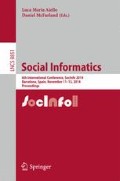Abstract
Gender differences in human social and communication behavior have long been observed in various contexts. This study investigates such differences in the case of online social networking. We find a general tendency towards gender homophily, more marked for women, however users having a large circle of friends tend to have more connections with users of the opposite gender. We also inspect the temporal sequences of adding new friends and find that females are much more likely to connect with other females as their initial friends. Through studying triangle motifs broken down by gender we detect a marked tendency of users to gender segregation, i.e. to form single gender groups; this phenomenon is more accentuated for male users.
Access this chapter
Tax calculation will be finalised at checkout
Purchases are for personal use only
Preview
Unable to display preview. Download preview PDF.
References
Ahn, J.: Teenagers and social network sites: Do off-line inequalities predict their online social networks? First Monday, 17(1) (2011)
Boyd, D.: It’s complicated: the social lives of networked teens (2014)
Cook, S.G.: Women lead in adopting new technologies. Women in Higher Education 21(2), 24–25 (2012)
Darwin, C.: The Descent of Man and Selection in Relation to Sex. John Murray (1871)
Drabowicz, T.: Gender and digital usage inequality among adolescents: A comparative study of 39 countries. Computers & Education 74, 98–111 (2014)
Duggan, M., Brenner, J.: The demographics of social media users – 2012. Pew Research Center (2013)
Eurobarometer. E-communications household survey summar. Technical report, Public Opinion Analysis, European Comission (2010)
Hoffman, A.: The Social Media Gender Gap. Bloomberg Businessweek (May 2008)
Instituto Nacional de Estadistica. Mujeres y hombres en españa. Technical report (2013)
Iosub, D., Laniado, D., Castillo, C., Morell, M.F., Kaltenbrunner, A.: Emotions under discussion: Gender, status and communication in online collaboration. PloS one 9(8), 104880 (2014)
Kaltenbrunner, A., Scellato, S., Volkovich, Y., Laniado, D., Currie, D., Jutemar, E.J., Mascolo, C.: Far from the eyes, close on the Web: impact of geographic distance on online social interactions. In: Proceedings of ACM SIGCOMM Workshop on Online Social Networks (WOSN 2012). ACM (2012)
Kivran-Swaine, F., Brody, S., Naaman, M.: Effects of gender and tie strength on twitter interactions. First Monday 18(9) (2013)
Laniado, D., Kaltenbrunner, A., Castillo, C., Morell, M.F.: Emotions and dialogue in a peer-production community: the case of Wikipedia. In: Proc. WikiSym (2012)
Lewis, K., Kaufman, J., Gonzalez, M., Wimmer, A., Christakis, N.: Tastes, ties, and time: A new social network dataset using Facebook.com. Social Networks 30(4), 330–342 (2008)
MacManus, R.: Study: Women outnumber men on most social networks. Report by Rapleaf (2008), http://readwrite.com/2008/07/29/social_networks_women_outnumber_men
Madden, M., Lenhart, A., Cortesi, S., Gasser, U., Duggan, M., Smith, A., Beaton, M.: Teens, social media, and privacy. Technical report, Pew Internet Research (2013)
Magno, G., Weber, I.: International gender differences and gaps in online social networks. In: Social Informatics - Third International Conference, SocInfo 2014 (2014)
McPherson, M., Smith-Lovin, L., Cook, J.M.: Birds of a feather: Homophily in social networks. Annual Review of Sociology, 415–444 (2001)
Mehta, C.M., Strough, J.: Sex segregation in friendships and normative contexts across the life span. Developmental Review 29(3), 201–220 (2009)
Moreno, J.L.: Who shall survive? Foundations of sociometry, group psychotherapy and socio-drama. Beacon House (1953)
Newman, M.E., Park, J.: Why social networks are different from other types of networks. Physical Review E 68(3), 36122 (2003)
Ottoni, R., Pesce, J.P., Las Casas, D., Franciscani Jr, G., Meira Jr, W., Kumaraguru, P., Almeida, V.: Ladies First: Analyzing Gender Roles and Behaviors in Pinterest. In: Proc. ICWSM (2013)
Palchykov, V., Kaski, K., Kertész, J., Barabási, A.-L., Dunbar, R.I.: Sex differences in intimate relationships. Scientific Reports, 2 (2012)
Reeder, H.M.: The effect of gender role orientation on same-and cross-sex friendship formation. Sex Roles 49(3-4), 143–152 (2003)
Schwartz, H.A., Eichstaedt, J.C., Kern, M.L., Dziurzynski, L., Ramones, S.M., Agrawal, M., Shah, A., Kosinski, M., Stillwell, D., Seligman, M.E., et al.: Personality, Gender, and Age in the Language of Social Media: The Open-Vocabulary Approach. PloS One 8(9), e73791 (2013)
Stehlé, J., Charbonnier, F., Picard, T., Cattuto, C., Barrat, A.: Gender homophily from spatial behavior in a primary school: a sociometric study. Social Networks 35(4), 604–613 (2013)
Szell, M., Thurner, S.: How women organize social networks different from men. Scientific reports 3 (2013)
Thelwall, M.: Social networks, gender, and friending: An analysis of MySpace member profiles. Journal of the American Society for Information Science and Technology 59(8), 1321–1330 (2008)
Venkatesh, V., Morris, M.G.: Why don’t men ever stop to ask for directions? Gender, social influence, and their role in technology acceptance and usage behavior. MIS Quarterly, 115–139 (2000)
Vigil, J.M.: Asymmetries in the friendship preferences and social styles of men and women. Human Nature 18(2), 143–161 (2007)
Volkovich, Y., Scellato, S., Laniado, D., Mascolo, C., Kaltenbrunner, A.: The Length of Bridge Ties: Structural and Geographic Properties of Online Social Interactions.. In: Proc. ICWSM (2012)
Zillien, N.: Digitale Ungleichheit. Springer (2008)
Author information
Authors and Affiliations
Editor information
Editors and Affiliations
Rights and permissions
Copyright information
© 2014 Springer International Publishing Switzerland
About this chapter
Cite this chapter
Volkovich, Y., Laniado, D., Kappler, K.E., Kaltenbrunner, A. (2014). Gender Patterns in a Large Online Social Network. In: Aiello, L.M., McFarland, D. (eds) Social Informatics. SocInfo 2014. Lecture Notes in Computer Science, vol 8851. Springer, Cham. https://doi.org/10.1007/978-3-319-13734-6_10
Download citation
DOI: https://doi.org/10.1007/978-3-319-13734-6_10
Publisher Name: Springer, Cham
Print ISBN: 978-3-319-13733-9
Online ISBN: 978-3-319-13734-6
eBook Packages: Computer ScienceComputer Science (R0)

